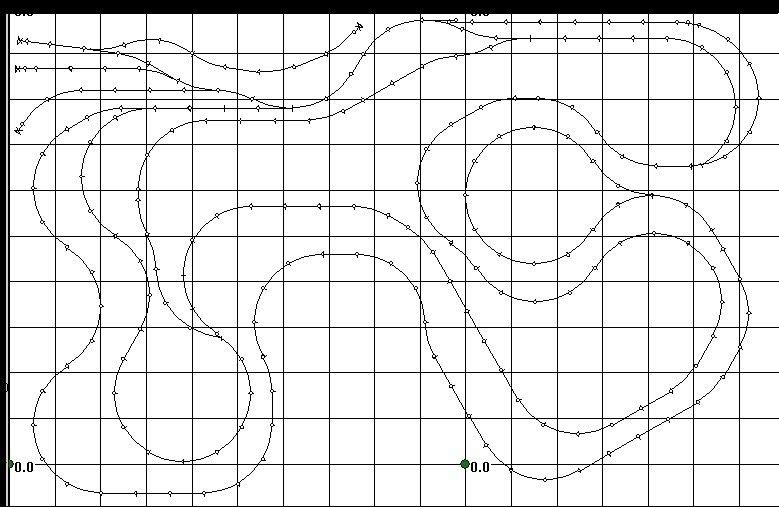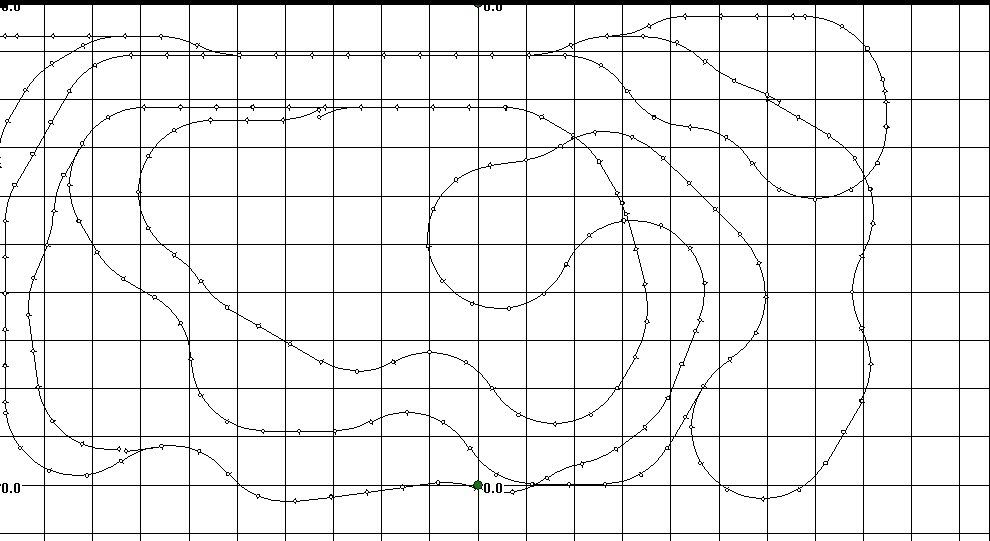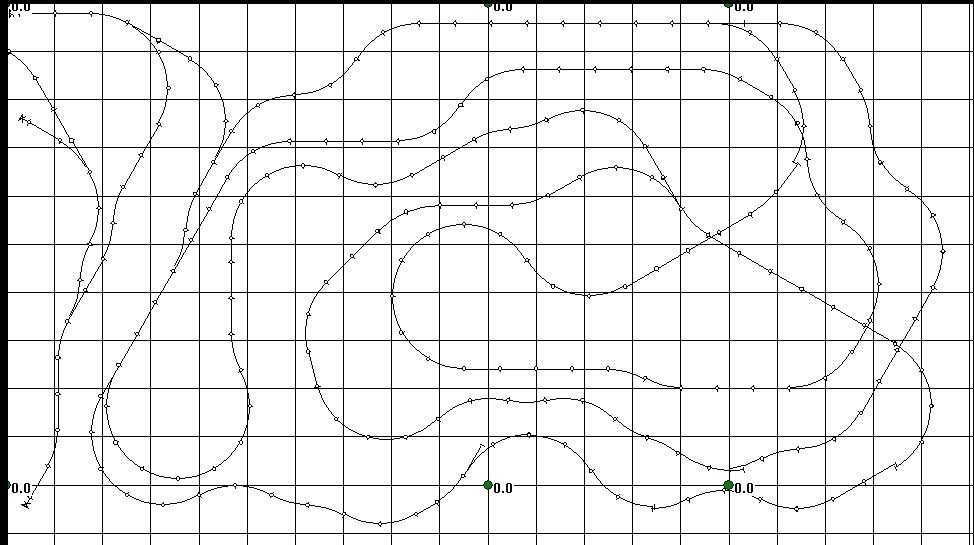First Layout Design
- Thread starter DJboutit
- Start date
You are using an out of date browser. It may not display this or other websites correctly.
You should upgrade or use an alternative browser.
You should upgrade or use an alternative browser.
Are you really sure u wanna jump straight into the deep end with such a big layout for your first???But if your prepared to goodluck with it
Nathan
Nathan
I'm going to suggest that if you actually tried to build any of these designs, you would be tearing your hair out in frustration, and never completing it.
The first issue is access to build, maintain, and operate. Unless you build the layout at waist level, and are comfortable with leaning over your work, most humans are limited to a maximum reach of 30". Even working on something just 30" from the edge of the benchwork tends to be difficult and fatiguing. By building low, and assuming a strong back and longer than normal reach, you might be able to go 36" in from the benchwork edge. So aisles are a big part of designing a layout.
2nd issue is vision or purpose. What are YOU trying to achieve with YOUR layout?
I would suggest spending a lot of time reading the threads on the forum about layout design. Also, spend time just thinking about what you want to see/do when your layout is operating. The more specific you get, the more likely the design is to reflect and achieve what you want.
I say these things because even a reasonably complete 4x8 in HO will cost $500-$1000 if you don't have most of the stuff to start with. The 4x8 will also take on the order of a year of hobby time or more to reach a reasonably complete stage. Your designs will cost considerably more, and will take much longer. If it turns out to be wasted effort and $$ because you are dissatisfied with the result, you (and wife if you have one) are not going to be a happy camper.
my thoughts, your choices
The first issue is access to build, maintain, and operate. Unless you build the layout at waist level, and are comfortable with leaning over your work, most humans are limited to a maximum reach of 30". Even working on something just 30" from the edge of the benchwork tends to be difficult and fatiguing. By building low, and assuming a strong back and longer than normal reach, you might be able to go 36" in from the benchwork edge. So aisles are a big part of designing a layout.
2nd issue is vision or purpose. What are YOU trying to achieve with YOUR layout?
I would suggest spending a lot of time reading the threads on the forum about layout design. Also, spend time just thinking about what you want to see/do when your layout is operating. The more specific you get, the more likely the design is to reflect and achieve what you want.
I say these things because even a reasonably complete 4x8 in HO will cost $500-$1000 if you don't have most of the stuff to start with. The 4x8 will also take on the order of a year of hobby time or more to reach a reasonably complete stage. Your designs will cost considerably more, and will take much longer. If it turns out to be wasted effort and $$ because you are dissatisfied with the result, you (and wife if you have one) are not going to be a happy camper.
my thoughts, your choices
A good short read on layout design is here: Space Mouse Rail Systems
Highly recommended for getting started. You may choose to ignore Chip's advice, but at least you will be doing so from a point of knowledge, and for reasons you understand.
yours in layout design
Highly recommended for getting started. You may choose to ignore Chip's advice, but at least you will be doing so from a point of knowledge, and for reasons you understand.
yours in layout design
Fred makes some good points: if you can't reach it, it's going to get tiresome really quickly. Another thing that I notice is that you have several curves that look to be under 18" radius. For HO, this is generally considered to be the minimum, and also something to be avoided if possible. With the amount of room that you have available, I'd be looking at 30" minimum. Your track plan reminds me of what we used to call "spaghetti bowl" trackplans: cram as much track as possible into the space available, and to heck with realism, operation as opposed to just running trains, and simplicity. And there's nothing wrong with just "running trains", if that's what appeals to you, but you could have more fun with less track.
With the area that you have available, you could have an around-the-room layout with 30" minimum radii, continuous running if you wanted it, easy access to all parts of the layout, and a layout with the potential to hold your interest for years. Your trackplans remind me of that Family Circus cartoon, where a dotted line shows the path taken by the kid to go to the house next door - your train will be wandering around on a long (and torturous) trip for no apparent reason. You've left no room for sidings, industry, or scenery. In the Weathering Forum, you talk about buying a layout that has most of the trackwork done, because you don't like doing trackwork, but you do like doing scenery. No wonder you don't like doing trackwork!
 :-D And your plans will leave little room for scenery, unless you plan on building lots of tunnels.
:-D And your plans will leave little room for scenery, unless you plan on building lots of tunnels. 
Take a look at Fred's link, and check out the Trackplanning Forum here, too.
And please don't misconstrue my comments: there are lots of us here that can assist you in making a layout that you'll truly enjoy, both in the building and the operation. Start by getting some more information that will help you to decide what you really want and then go from there.
Wayne
With the area that you have available, you could have an around-the-room layout with 30" minimum radii, continuous running if you wanted it, easy access to all parts of the layout, and a layout with the potential to hold your interest for years. Your trackplans remind me of that Family Circus cartoon, where a dotted line shows the path taken by the kid to go to the house next door - your train will be wandering around on a long (and torturous) trip for no apparent reason. You've left no room for sidings, industry, or scenery. In the Weathering Forum, you talk about buying a layout that has most of the trackwork done, because you don't like doing trackwork, but you do like doing scenery. No wonder you don't like doing trackwork!
Take a look at Fred's link, and check out the Trackplanning Forum here, too.
And please don't misconstrue my comments: there are lots of us here that can assist you in making a layout that you'll truly enjoy, both in the building and the operation. Start by getting some more information that will help you to decide what you really want and then go from there.
Wayne
I would heed Fred's advice. Some of my yard is 40" reach and it was a killer trying to lay track. Leaning over/laying on that table for an hour or two is not fun. So I tried to hurry and made lots of mistakes that I had to go back and fix. Just my experience.
Loren
Loren
One more thing I would add is give us details about your layout space, room, etc. An island layout as big as those you drew up will require a minimum 2 foot walkway all the way around the table. Presuming that the 10 x 14 table would work in your layout space, you would need a room with a minimum dimension of 14 x 18, but better would be 16 x 20. You would have room in that space to build an around the walls shelf with a peninsula or two and a balloon track for return loops at each end. Such designs would give you much more mainline with a sense of the railroad going some place rather than wandering aimlessly. You would also have more room for scenery, industries, towns separated by believable country distances, etc.
Also you could build relatively inexpensive long folded dog bone style mainline that would allow you to run some trains and learn what you like in the hobby, if you are not sure already. As you decide what industries to add and where to put them, it is not too difficult to cut out sections of track to install switches and run sidings for your industries, or passing sidings, etc. I guess the overriding factor in layout design is to remember that the prototype always lays track for a purpose. Visualise your purpose for each track you put down and you will have a much more satisfying layout.
Also you could build relatively inexpensive long folded dog bone style mainline that would allow you to run some trains and learn what you like in the hobby, if you are not sure already. As you decide what industries to add and where to put them, it is not too difficult to cut out sections of track to install switches and run sidings for your industries, or passing sidings, etc. I guess the overriding factor in layout design is to remember that the prototype always lays track for a purpose. Visualise your purpose for each track you put down and you will have a much more satisfying layout.
Another thing- they are all SPAGETTIE BOWLS! Don't stress, you're a normal model railway enthusiast, my first few designs were also ellaborate.
Don't worry, we'll help you out, remember, it's not the amount of tracks that always make a layout, but the rest of the stuff (scenery, etc.) that finish it off.
Don't worry, we'll help you out, remember, it's not the amount of tracks that always make a layout, but the rest of the stuff (scenery, etc.) that finish it off.
By the way, I think some of those track plans are a little larger than the room you specified. Assuming the grid lines are 1 foot apart, I think you would have to fit the plan into the space marked 0.0 with the green dot.
Also, be very careful of those "s" curves that you have drawn into the plan, those are a real quick way to get frustrating derailments. It's hard enough to keep trains on straight track sometimes :mrgreen:
Lastly, some of those look to be wiring nightmares, especially if you are a new modeler and not familiar with wiring. There are lots of hidden reverse loops that could prove to be problematic, especially if it is hard to follow the trackplan.
Just my thoughts,
Ginns
Also, be very careful of those "s" curves that you have drawn into the plan, those are a real quick way to get frustrating derailments. It's hard enough to keep trains on straight track sometimes :mrgreen:
Lastly, some of those look to be wiring nightmares, especially if you are a new modeler and not familiar with wiring. There are lots of hidden reverse loops that could prove to be problematic, especially if it is hard to follow the trackplan.
Just my thoughts,
Ginns
Don't be discouraged by some of the negative comments. I would bet that none of us drew a successful track plan the first time we tried. Hang in there and stay with us and you'll be an experienced "old timer" before you know it. It is amazing how fast you can pick stuff up when you hang around experienced modelers.
Since you're drawing both 10x10 and 10x14 layouts, how much space do you actually have?
Do you know what you want out of model railroading? Imagine yourself running a layout. What is it you imagine?
Do you know what you want out of model railroading? Imagine yourself running a layout. What is it you imagine?
your designs, while complicated...could work just fine with pop-outs...or if you built it in chunks and assembled it...but it would take a long time (which is fine).
You actually could make some pretty cool scenery with some aspects of the plans...but that makes it more difficult. Nothing is worse than having a derailment in a hard to reach spot (i remember a cartoon in Model Railroader magazine of a guy using a fishing pole to rescue a train from a tunnel.
Many of us like to create the illusion of our trains going somewhere. Model railroads can very from just simply watching locomotives pull strings of cars (train sets)...to complex point-to-point railroads that are operated exactly like real railroads (with dispatchers sitting in closets to simulate control towers 100s of miles away) and scenery that can be confused with reality.
The following is an example of a small railroad (which had the illusion of going somewhere) which grew into a 27' by 33'...from John Allen's Gorre and Daphetid Railroad - A Reminiscence

Here's a picture on that smaller than 4x8...

Which grew into this a little more than 20 years later...

That was built by the late John Allen
It is a great example of starting small...and expanding to bigger things...as the original 20ish square foot layout was still at the center of his masterpiece.
You actually could make some pretty cool scenery with some aspects of the plans...but that makes it more difficult. Nothing is worse than having a derailment in a hard to reach spot (i remember a cartoon in Model Railroader magazine of a guy using a fishing pole to rescue a train from a tunnel.
Many of us like to create the illusion of our trains going somewhere. Model railroads can very from just simply watching locomotives pull strings of cars (train sets)...to complex point-to-point railroads that are operated exactly like real railroads (with dispatchers sitting in closets to simulate control towers 100s of miles away) and scenery that can be confused with reality.
The following is an example of a small railroad (which had the illusion of going somewhere) which grew into a 27' by 33'...from John Allen's Gorre and Daphetid Railroad - A Reminiscence

Here's a picture on that smaller than 4x8...

Which grew into this a little more than 20 years later...

That was built by the late John Allen
It is a great example of starting small...and expanding to bigger things...as the original 20ish square foot layout was still at the center of his masterpiece.




